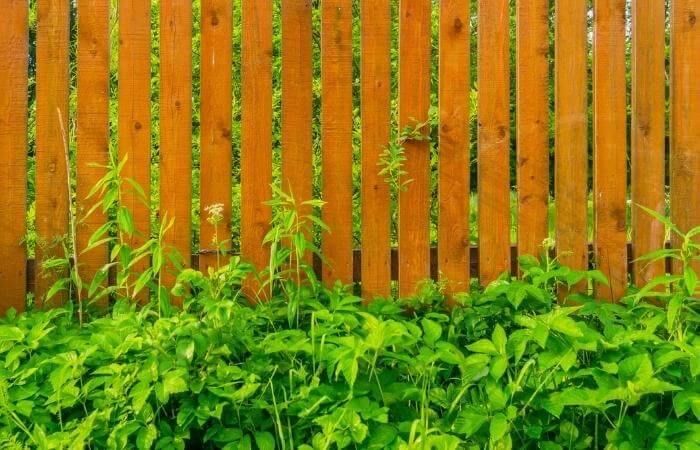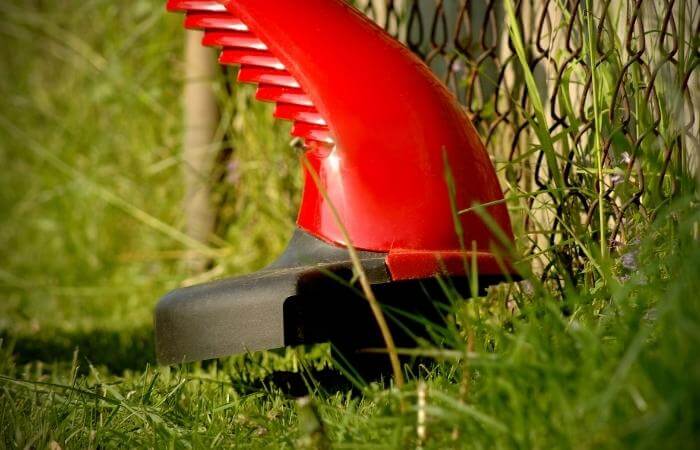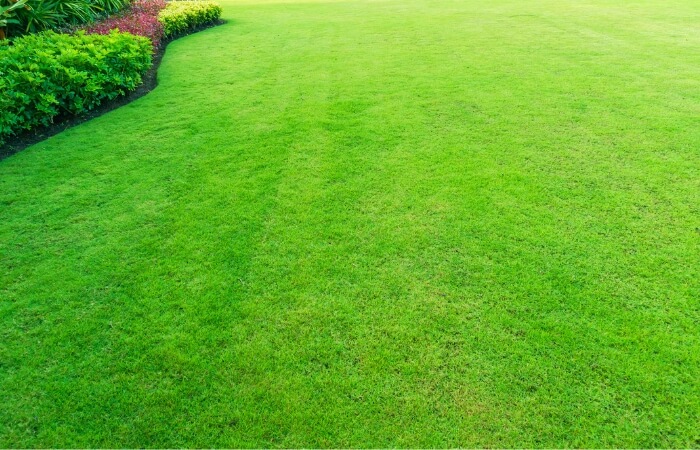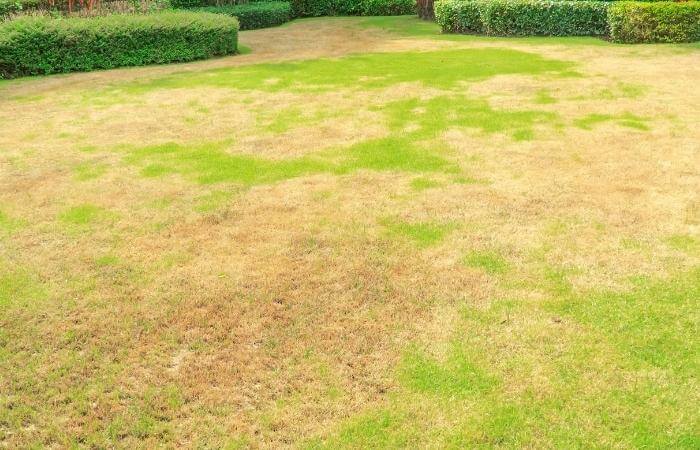When you work hard to create a beautiful lawn, it’s frustrating to deal with weeds spreading from your neighbor’s yard.
Many homeowners want to know how to fix the issue of weeds growing under fences or crossing property lines, so I put the best solutions in this guide to weed control for your lawn.

From under fence weed barrier options, clever landscaping prevention, and things you want to avoid, all the answers are right here, so keep on reading!
Main Reasons Weeds Enter Your Lawn
There are many ways weeds can enter your yard and take root in your grass and landscaping, including:
- Windblown seeds
- Root growth or runner spread
- Bird droppings
- Runoff from rain or sprinkler systems
- Animals
While you can’t control the spread of all weeds from your neighbor or through wildlife or wind from farther away, you can significantly reduce their impact on your yard.

By using the methods I detail below, you can slow down new weed growth in your grass.
When you only need to deal with a few weeds here and there, it’s much easier to stay on top of weed removal, so your lawn remains lush and green.
What To Avoid With Neighbors
Keeping weeds from migrating from your neighbor’s lawn to yours is going to be an ongoing battle for most homeowners.
What you want to avoid in the process is making things worse by the products or methods you use to try to eliminate weed spread.
Neighbor Fueds
The biggest thing you want to avoid is causing a rift between you and the offending neighbor by demanding they “do something” to keep their weeds out of your yard.
Weeds popping up inside your property lines are not all your neighbor’s fault. Seeds can travel great distances and are incredibly resilient.
Another issue could be illness or mobility issues that prevent the house next door from adequately maintaining their yard.
The best approach is to chat with your neighbor and explain how hard you’re working to improve the look of your lawn.
Discuss products and tips that are working for you, and if they seem open to suggestions or state they can’t physically handle lawn care, you can offer to assist them in some way.
In reality, the neighbors might not care about their lawn or how it affects their neighbors. This scenario means that you’re on your own but don’t hold a grudge.
Harmful Weed-Killing Chemicals
Dousing weeds from your yard with powerful weed killers will create damage to more than your grass.
Aside from ugly brown dead patches in your lawn, some weed-kill products can kill off beneficial soil microbes, runoff into rivers and streams, causing wide-range environmental damage, and be harmful to pets and people, especially kids.
Mulch
You’ll want to avoid using a layer of mulch under a fence.
Mulch will eventually decay and need continual replacement, can cause wood fence bottoms to rot out, can cause fence staining, or attract unwanted insects to your yard.
Eliminate Bird Feeders
If random weeds in your lawn drive you crazy, you may want to consider removing bird feeders from your property.
Birds enjoy a free meal and leave behind droppings that often contain seeds from invasive weeds. Squirrels are another carrier of seeds in their droppings, and they love to plunder bird feeders.
How To Keep Grass From Growing Under Fence

The best way to keep grass from growing under fence lines is to lay down a barrier.
The barrier will prevent annoying tall grass from growing up along the fence that the mower misses or from having invasive weeds or grass creeping across from your neighbor’s lawn.
You can do this with rocks, bricks, cement, rubber, or other material. You can lay down a Grass Barrier or a Rubber Mulch Mat or a similar product directly under the base of a fence to prevent grass growth.
Follow these steps to create an effective under fence weed barrier:
Step 1: Make A Plan
Before you start, you need a plan.
Answer these questions before moving on:
- What type of material will you use?
- How long is the fence and how much space is underneath?
- How wide do you want the barrier?
- Color choice (blend with landscape or stand out)?
- Will you need weed-barrier fabric under your material?
If your fence has a nice gap underneath, it’ll be much easier to roll or lay a barrier to stop the grass from growing. Digging a trench under the fence is going to take a lot more effort.
Are you blessed with an energetic dog that loves to run or dig along the fence? You may want to avoid using rocks that move easily and use something more solid instead.
Step 2: Prep The Fence Line
Clear away tall grass along the entire fence line by mowing and weed-eating. If you don’t have space under the fencing to slide and secure a barrier material over the existing grass, use a flat shovel to scoop out the area.
Grass under a barrier material will die off after several weeks without any effort on your part.
It’s best to dig a trench for rocks or bricks to have a secure place to sit. Lowering the material into the ground also keeps the barrier and the grass level so you can mow cleanly without damaging the blades.
Use short stakes and a string line to keep your barrier straight and even.
Step 3: Install The Barrier
Spread out rolls or sections of rubber or plastic barrier material along the fence. Cut sections to fit between the fence posts or notch them out to go around them as you work along the perimeter.
Use garden stakes or spikes to hold the material in position so it won’t move about.
For rocks, lay down a weed-preventer material into your shallow trench and shovel in the material.
Push bricks or patio blocks closely together and lay them under the fence, making sure to keep them level and straight along your string line.
Step 4: Finish Landscaping
Once you finish installing your grass barrier, you can landscape the yard as you choose.
For a clean grass-edge appearance, you can leave your barrier as is.
If you wish to landscape further, you can add planters in front of your fence barrier to soften the look of your yard.
Other Methods To Prevent Your Neighbors Weeds In Your Yard
Vertical Edging
Stop weeds that spread through roots or runners by pounding in a vertical barrier tight against your fence.
Most are made of metal or dense plastic 6-8 inches in depth, so the material goes far enough into the dirt to stop roots from crossing but keeps a couple of inches above the ground to stop runners.
Plant Hedges
Thick hedges act as a windscreen to reduce the number of seeds blowing onto your lawn. A wall of plants even three feet tall can work wonders to stop migrating weeds.
Consider mulching along the bottom of hedges with stone to increase weed reduction.
Create Landscape Berms
If your yard lacks fencing or has wide gaps underneath, consider creating some berms along your property line. The hills will act as a windbreak and physical barrier to stop encroaching weeds.
A pile of dirt 1-3 feet tall, with bushes on top, creates a natural fence line. Fill the bermed area edges with rocks or mulch to add another layer of protection against weeds taking root.
Use Pre-Emergent Herbicide and Lawn Weed-n-Feed
Every spring, before new grass begins to sprout, broadcast a safe pre-emergent herbicide over your lawn. Using this product means weed seeds lurking in the soil ready to sprout don’t germinate.
During the growing season, use a weed-and-feed grass fertilizer to improve lawn health for thicker growth that chokes out weeds. Any weeds that have taken root will die before they can set seed.
You can also pull any random weeds in your grass by hand as soon as you see them appear.
Control Runoff
If your neighbor’s lawn runs off into yours during heavy rains, the water is also going to be bringing along an array of seeds.
To stop runoff from leaving behind seeds that will make a new home in your lawn, create proper drainage or use berms to force the water to stay on their side of the property line.
In Summary
Nobody will have a perfect, weed-free lawn, but with the right products and landscaping features, you can improve your yard’s appearance and keep the peace with your neighbor.
I hope you put the tools inside this guide to use, so you can reduce neighbors’ weeds spreading to your lawn. Who knows, maybe because your yard looks so impressive, they’ll work to improve their lawn too! Now that would be a real win-win weed-control solution!










